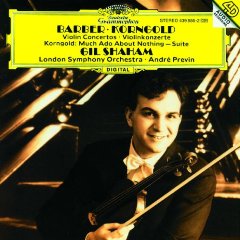Erich Wolfgang Korngold – Violin Concerto in D major, Op. 35 (Shaham) [1994]
Erich Wolfgang Korngold – Violin Concerto in D major, Op. 35 (Shaham) [1994]

I. Moderato nobile II. Romanze: Andante III. Finale: Allegro assai vivace Gil Shaham (Violin) London Symphony Orchestra André Previn (Conductor)
In 1906, the then-nine-year-old Erich Wolfgang Korngold's cantata Gold elicited from Gustav Mahler the response "A genius!" Korngold went on to become one of the most prolific composers of his generation, writing in every serious genre and making a particularly strong impact as a composer of operas, receiving unanimous acclaim for his Violanta of 1916, and repeating the success with his Die tote Stadt, staged triumphantly in both Hamburg and Cologne during 1920. But in 1934, Korngold settled in Hollywood, where he renewed his associations with the theatre director Max Reinhardt, and went on to become the most celebrated of a generation of European émigré composers who are best remembered for their film scores.
Korngold's most popular movie scores included King's Row, The Seahawk, Anthony Adverse, and Robin Hood. But despite the acknowledged quality of his works for the silver screen, it would be idle to pretend that these served greatly to enhance Korngold's repute as a "serious" composer. What did help enormously in this regard was the support and patronage of great artists, among them the celebrated violinist Jascha Heifetz, for whom Korngold composed his Violin Concerto in D major, Op. 35, during 1945. Other key orchestral works by Korngold included a cello concerto for Piatigorsky, and a brilliantly accomplished symphony in F sharp minor.
The violin concerto is an unashamedly romantic work, with a vibrantly cinematic character, begging the lie that no "hack" celluloid composer could write a work that not only ranked as one of the best concertos of its time, but also retained the populist feel of a Hollywood movie in the unforgettable contouring of its thematic material. The concerto comprises three movements. In the first (Moderato mobile), the soloist enters almost at once, with a lush, broadly stated melody that is quintessential Korngold. The music moves steadily forward into a faster-moving episode, with constant reminders of the opening ideas, and making searching demands on the soloist as a result of its highly rhapsodic style. The movement also includes a virtuoso cadenza and a final coda of arresting power. The central movement (Romanze) brings the required contrast, in a delicately scored piece in which the soloist reflects at length on material of a touchingly nostalgic coloration. A powerfully assertive mood prevails once again with the arrival of the finale (Allegro assai vivace), whose angular, strongly motoric rhythms serve as reminder that Korngold came from the same creative stable as Schoenberg and Zemlinsky (his childhood mentor), while also being a modernist in the sense of being fully able to write in a totally original, independent manner. Again, the movement calls for outstanding technique and fearless virtuosity, but a more relaxed and lyrical central episode again brings the required contrast. The closing section, a thrilling pyrotechnic tailpiece, again imposes severe technical demands on soloist and orchestra alike. ---Rovi
download: uploaded filecloudio anonfiles yandex 4shared solidfiles mediafire mega nornar
Zmieniony (Piątek, 24 Styczeń 2014 15:23)








